[FONT="]The Finlay Axe
[/FONT][FONT="]
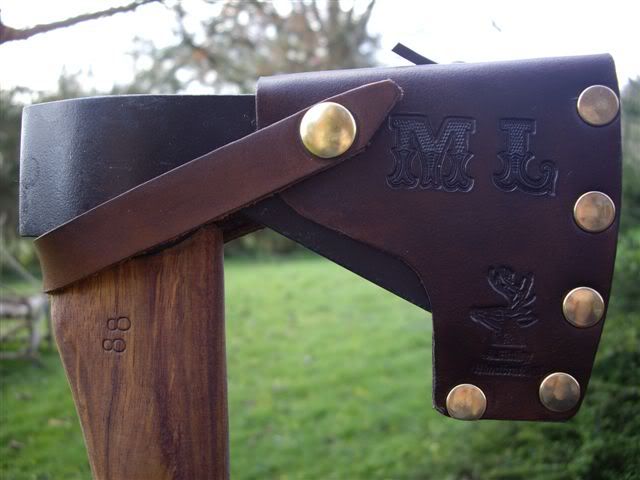 [/FONT]
[/FONT]
[FONT="]
[/FONT][FONT="]
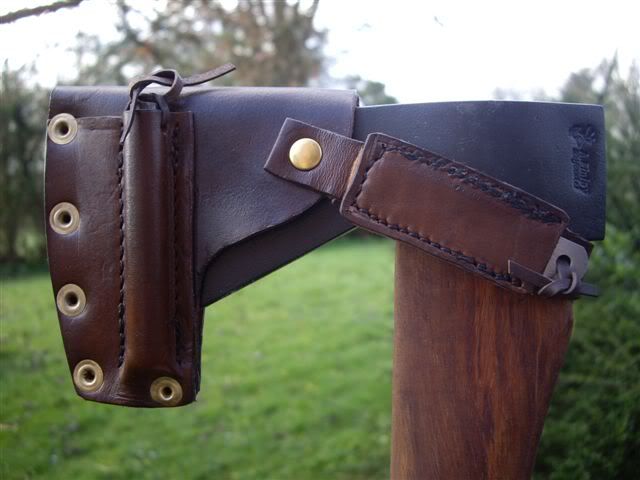 [/FONT]
[/FONT]
[FONT="]
This review has been done for BCUK Members. It is an initial, first impressions comparison between a Gransfors Bruks Small Forest Axe (SFA) and an Alan Finlay Large Bushcraft Axe (The Finlay). The SFA needs no introduction and is often used as a benchmark for bushcraft axes. It seems only natural to compare the Finlay Axe, which is made specifically for bushcraft woodsman use, with the SFA.
http://www.a-finlay-primitive-crafts.co.uk/woodsman_axe_large.html
Main similarities between the SFA and the Finlay:
[/FONT]
[/FONT]
[/FONT]
The Finlay
[/FONT]
[/FONT]
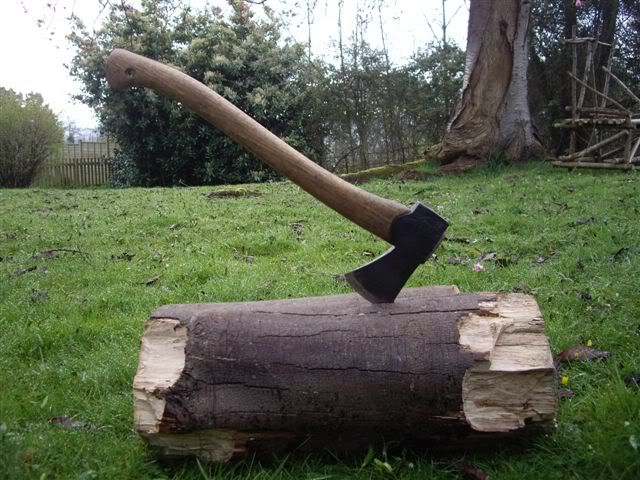
sfa
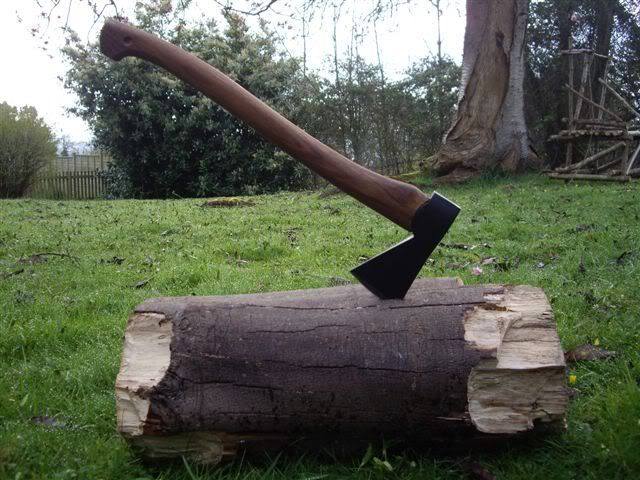
finlay
[/FONT][FONT="]
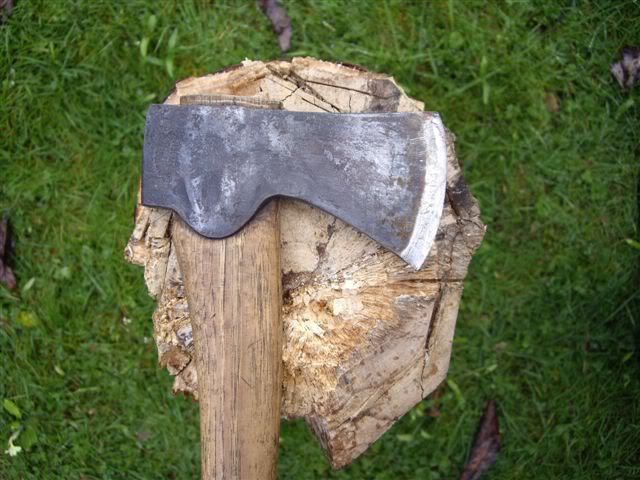 [/FONT]
[/FONT]
[FONT="]sfa

finlay
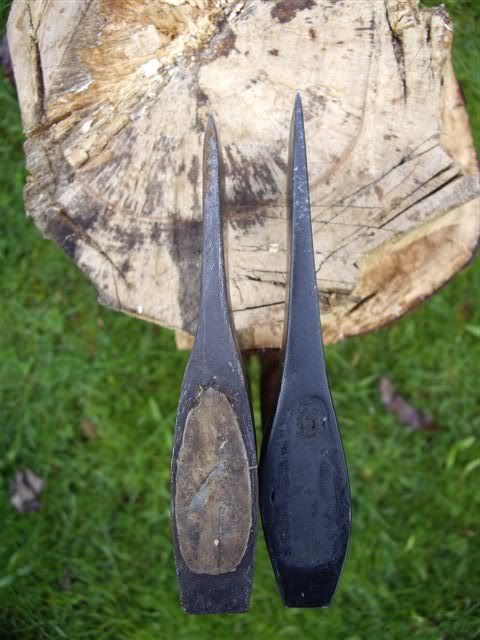
sfa finlay
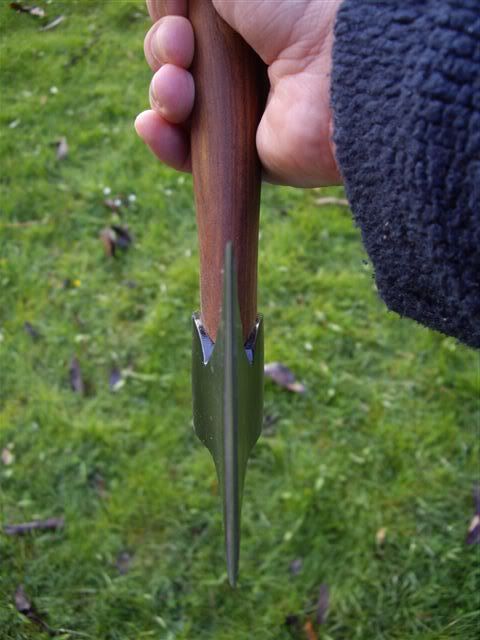
finlay
[/FONT][FONT="]
 [/FONT]
[/FONT]
[FONT="] sfa
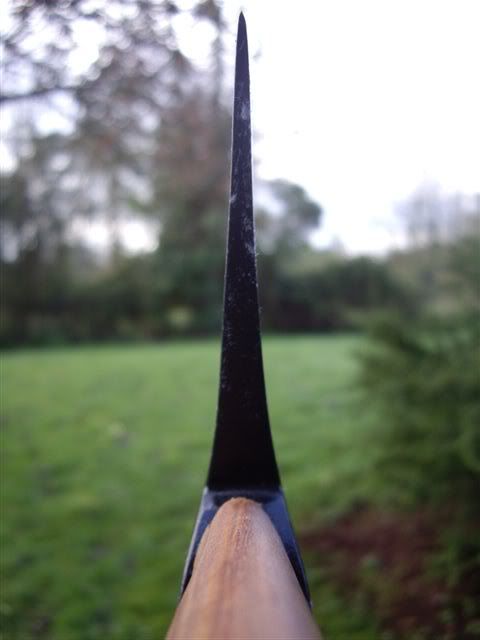
finlay
[/FONT][FONT="]
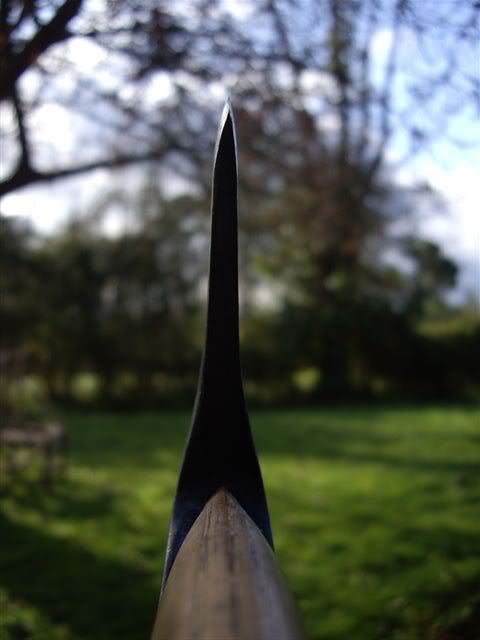 [/FONT]
[/FONT]
[FONT="] sfa
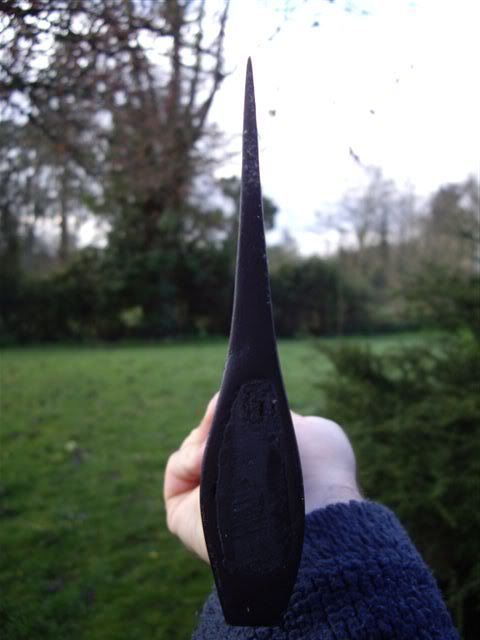
finlay
[/FONT][FONT="]
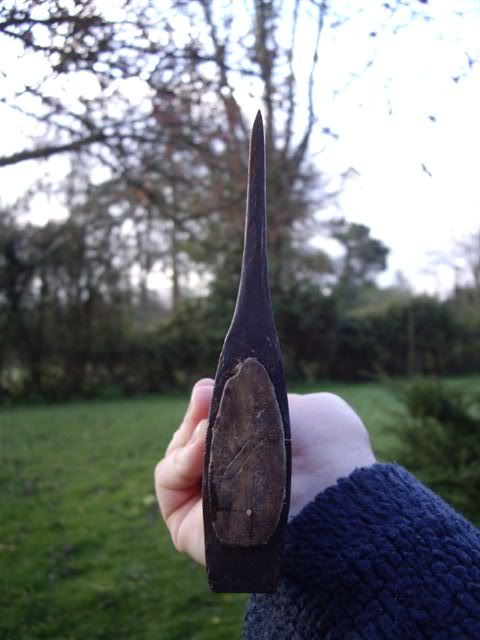 [/FONT]
[/FONT]
[FONT="] sfa

finlay
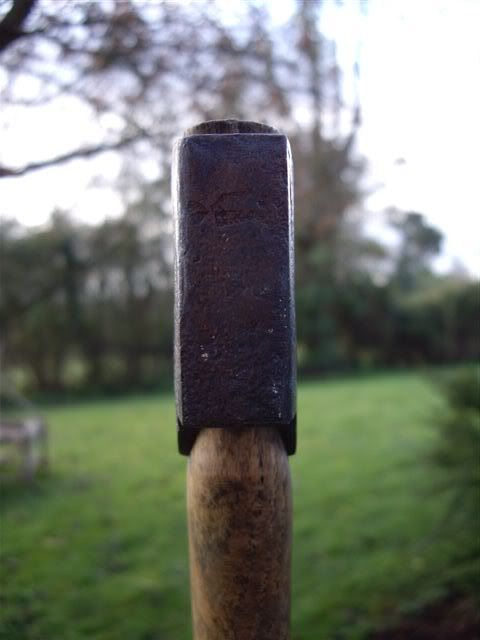
sfa
Basic Handling:
There is more of a 'sense' of control with the SFA because of the neutrality of the weight - many axes will have the weight just in front of the helve/shaft. The Finlay, by contrast, has its weight clearly in front of the helve. In that way the Finlay 'acts' like a larger axe but, you may argue, without the controlling weight. I am, as a result, convinced that the SFA is great for beginners as it is very forgiving: with confident placement that comes from a neutral-centred balance. See piccies, below.

sfa
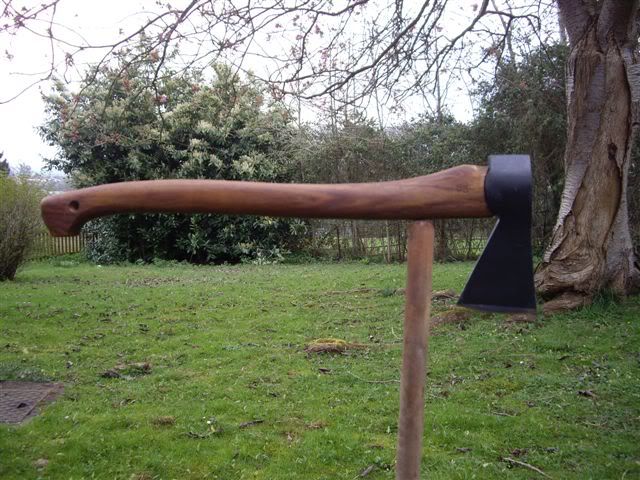
finlay
Placement of the cuts seems to still be a greater challenge with the Finlay but this may simply be because of my greater familiarity and habit of using an SFA. I still feel that the Finlay is for the more experienced user in order to get the best out of it. But only time will tell.
SFA centres slightly better in a cut. This might be due to the more convex, broader bevel or to the greater curve of the blade but more probably simply due to the experience of the user. It might also be because this SFA has a polished, lower friction finish to the bevel (see below), allowing it to do that.
The narrowness of the Finlay blade means it 'sticks' more than the SFA but this may be also because of the gummy paint finish on it that goes right up to very near the cutting edge/bit work to polish this part of the blade will probably signifantly improve performance in this area.
The Finlay definitely comes across as a faster, more aggressive feel to it than the SFA but I felt less tiring - probably due to its lighter mass.
Splitting:
Both the SFA and the Finlay split seasoned soft wood with no problem - this comes as no surprise as it does not present much challenge. However the more convex bevel and shorter blade (and greater weight) the SFA gives a perception of greater ease of action.. The Finlay has to cut deeper to get the same outward splitting pressure. The Finlay cuts deeper than the SFA anyway as the blade is both longer and also slightly narrower towards cutting edge - so the difference the end result for splitting is only very slight if anything at all. See piccies, below.


sfa
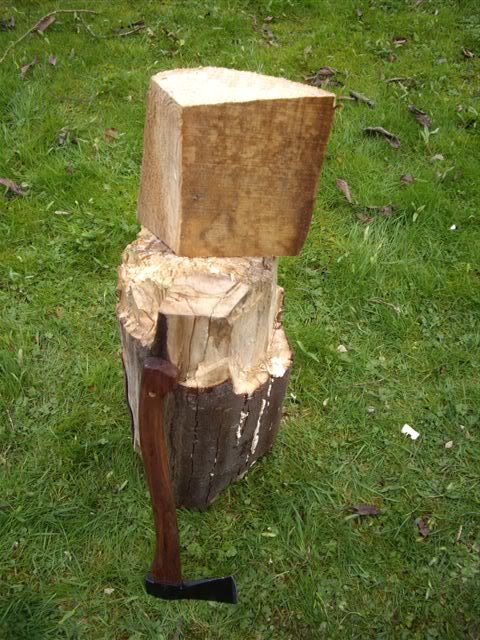
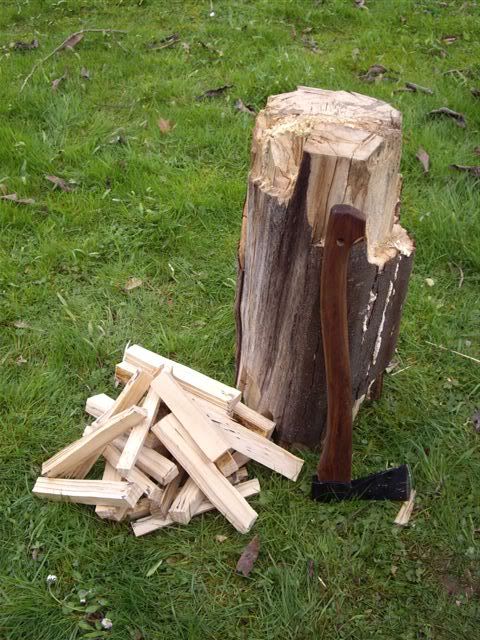
finlay
Part-seasoned wood:
I have included this type of wood because I seem to come across this - especially in coniferous woods. A fallen, shallow rooted, softwood tree that is somewhere between fully-seasoned and green. It presents some characteristics of both and is easy to come by. So it seemed sensible to test cross-grain cutting of the axes in this type of wood.
The Finlay, once again, gives the impression of cutting deeper in seasoned and part-seasoned wood with slightly less force or energy. The very, very narrow cross-section to the bevel (the bevel is not only very thin it is also narrow) it seems to find its way into the wood with less resistance. In some cases you could describe the SFA as thudding with its edge as it cut-cross grain.
You can see from the pictures that both the cuts are narrow. Particularly so with the Finlay. The Finlay has gone marginally deeper (with the same energy expended) with a narrow base to the bottom of the V). The damage to the wood/bark just either side of the main cut comes from the greater difficulty of placement. The SFA has cut a marginally wider V but with a broader, more messy base to the V. The cut was less deep for the same energy expended. It centred itself well and placement was accurate. See piccies, below.
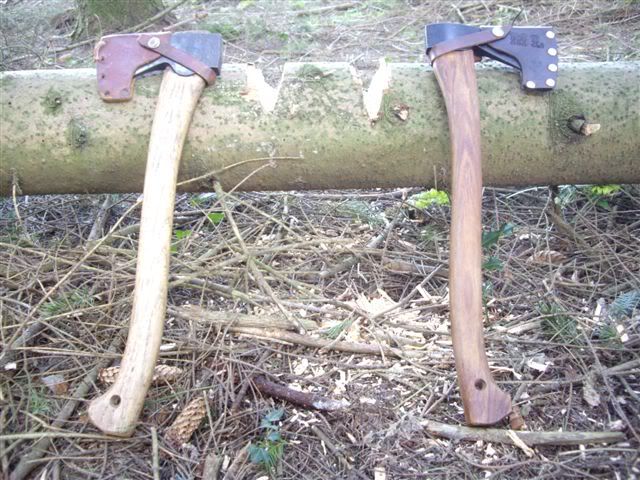
sfa finlay
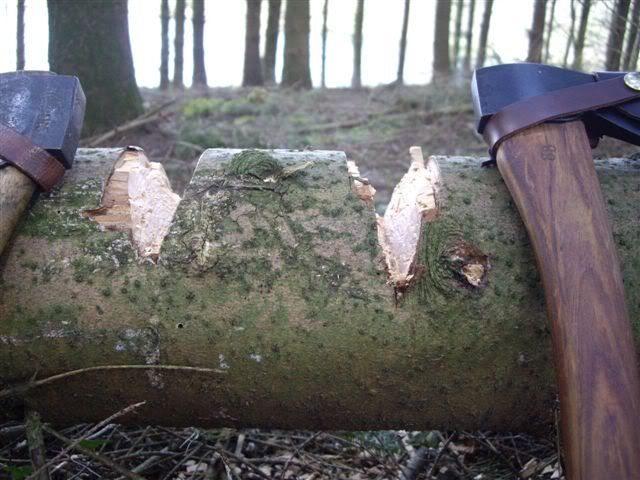
sfa finlay

sfa finlay
Limbing:
The Finlay seems to limb greenwood as well as the SFA but in a slightly different way (if that make sense) because the face is thinner there is a deeper cutting action, the SFA has a thicker profile but a curved face giving it a slicing action but the convex bevel giving more of a outward forcing action at the same time. There is however only a slight difference but not as far one does a better job than the other in the actual efficiency of the cut. Placement of the cuts seems to still be a greater challenge with the Finlay leading to the need for greater concentration to get an accurate placement. However, I suspect that this is due to me never handling this axe before. I still think that it needs more experienced handling to get the best out of it compared to the beginner-friendly SFA.
As you will see from the pictures both limbed easily and cleanly cut green softwood of 2-2 ½ inch branches is a few (3 to 4) half-power strokes. Neither axe stuck. See piccies below.

finlay
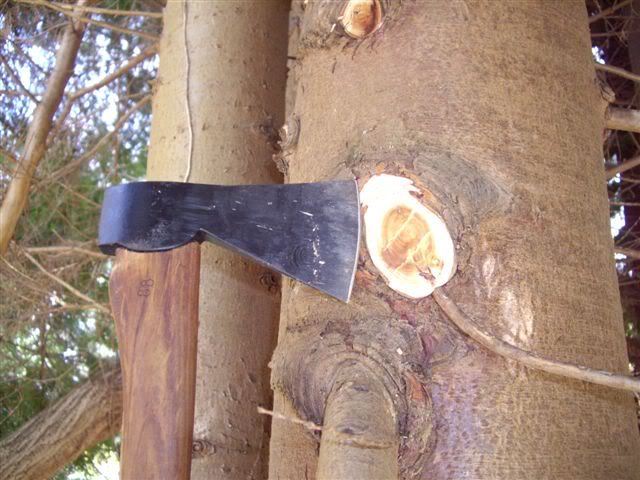
finlay
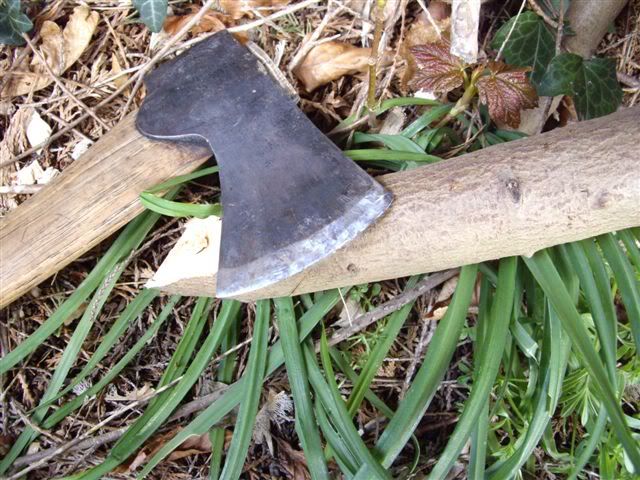
sfa
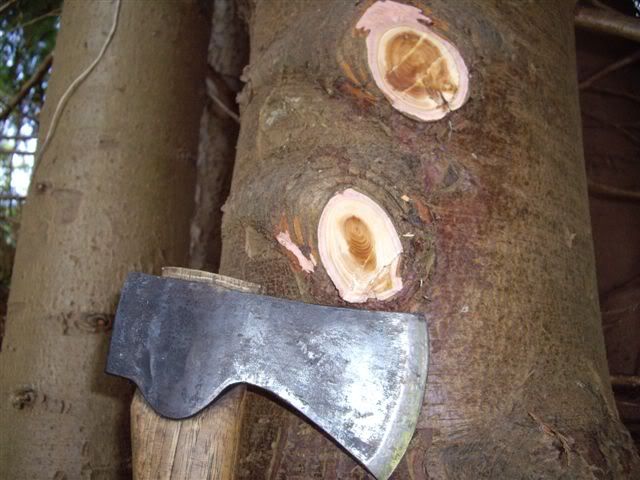
sfa
Carving:
I must firstly state that I am not an experienced axe carver!
Comparing characteristics with a carving axe it will often have a wide, flat bevel (possibly on one side) with a sharpened angle of 20-30 degrees.
I can't say that either axe - due to their bevel and head-shape are masters of carving. The narrow, concave cross-section of the blade face (the cheeks) and the narrow width of the bevel make for great limbing in green wood but are compromised - IMHO - when carving. Carving axes also have exaggerated curves to the blades. Whilst the SFA does have a light curve the Finlays very light curve is more akin to a carpenters axe (which is straight). However, the bevel of the Finlay is ground to between 20-30% which is in the zone for carving. A broader bevel would be good and this could be achieved by some reworking of this area. Neither of these axes, for instance would carve as well as a Roselli All-rounder I feel.
What does give the Finlay an advantage over the SFA - by quite some margin is control of the head. The high choke (what I call the narrow area of the head, just in front of the shaft that enables your fingers to grip the shaft behind the blade) on this head makes getting full control behind the edge a doddle and giving a dexterity of movement. The fine edge does have its advantages - making it marginally better to plane or flatten wood. The more extreme top and bottom sharp angled corners to the cutting edge also give different carving/cutting options for detailed work. Piccies to come.
Conclusion:
Both are axes that are set up for a similar type of use greenwood, limbing and kindling preparation, possibly with a little carving thrown in. But despite superficial similarities handle in quite different ways. Both are excellent axes and do their jobs well. I expect it will all boil down to personal preference and what suits your style. I do however feel that beginners and hardened SFA users will take some getting used to the Finlay in order for it to perform at its best and its best is really good. So, is it a quality alternative to the SFA and other bushcraft axes? Yes it is. Is it the perfect axe? No. It has its foibles, like every other axe I have tried. In the meantime Ill keep using it and seeing if I can become as confident at using it as I do with an SFA. I am sure it will be very rewarding.
I received 3 stitches to the hand doing this review.
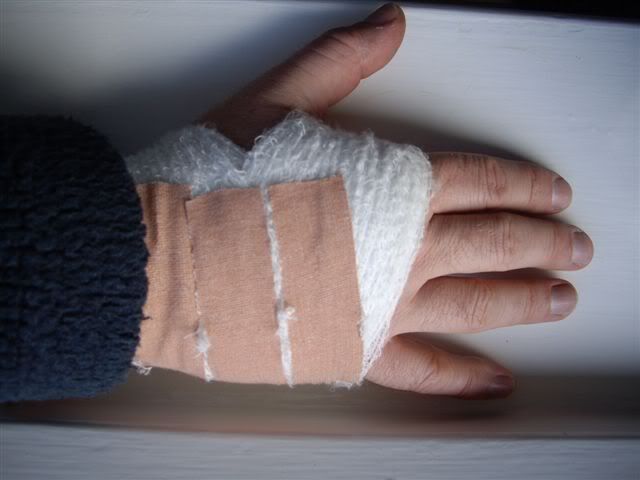
[/FONT]
[/FONT][FONT="]

[FONT="]
[/FONT][FONT="]

[FONT="]
This review has been done for BCUK Members. It is an initial, first impressions comparison between a Gransfors Bruks Small Forest Axe (SFA) and an Alan Finlay Large Bushcraft Axe (The Finlay). The SFA needs no introduction and is often used as a benchmark for bushcraft axes. It seems only natural to compare the Finlay Axe, which is made specifically for bushcraft woodsman use, with the SFA.
http://www.a-finlay-primitive-crafts.co.uk/woodsman_axe_large.html
Main similarities between the SFA and the Finlay:
[/FONT]
- [FONT="]Same length[/FONT]
- [FONT="]Broadly similar in design[/FONT]
- [FONT="]Both concave after the bevel (the cheeks), with thin blades ideal for greenwood and limbing[/FONT]
[/FONT]
- [FONT="]Needs little introduction[/FONT]
- [FONT="]Blade: 3 ¼ cutting edge[/FONT]
- [FONT="]Rockwell Hardness approx 57[/FONT]
- [FONT="]Shaft: 50cm of Hickory[/FONT]
- [FONT="]Machine Forged[/FONT]
- [FONT="]Entire package 2 ¼ lbs (or 900gms / 2 lbs without sheath)[/FONT]
[/FONT]
- [FONT="]Heavier[/FONT]
- [FONT="]Slightly larger shaft but less rounded, hickory and slightly shiny finish[/FONT]
- [FONT="]Weight is as much behind the head as it is in front of it making a neutral / centre balanced head.[/FONT]
- [FONT="]Shorter length to head (from hammer to cutting edge)[/FONT]
- [FONT="]Larger 'hammer' poll[/FONT]
- [FONT="]Greater curve to blade[/FONT]
- [FONT="]More convex / thicker cross-section to 'bevel'[/FONT]
The Finlay
[/FONT]
- [FONT="]Axe is designed and made by Alan Finlay. Originally Alan started out as a knifemaker but has expanded his repertoire to include a significant range of products including axes. He is based in near Ayr, Scotland. So is this the Scottish GB SFA?![/FONT]
- [FONT="]Blade: Length 16cm (6 ¼), Cutting edge 8cm (3 ½)[/FONT]
- [FONT="]Shaft: 50cm of oiled Rosewood[/FONT]
- [FONT="]Rockwell Hardness approx 58 [/FONT]
- [FONT="]Head Angle 20-30%[/FONT]
- [FONT="]The entire package weighs approx 1 ¾ lbs (or 700gms / 1 ½ lbs without sheath) on my scales (not the most accurate but gives a weight relative to each other)[/FONT]
- [FONT="]Handcast and handground head[/FONT]
[/FONT]
- [FONT="]Slightly lighter[/FONT]
- [FONT="]Rounded, matt-finish (oiled) rosewood shaft with straight grain[/FONT]
- [FONT="]Longer length to head (from hammer/poll to cutting edge)[/FONT]
- [FONT="]Weight is in front of shaft[/FONT]
- [FONT="]Smaller 'hammer'/poll[/FONT]
- [FONT="]Flatter curve to leading edge profile[/FONT]
- [FONT="]Very small, thin, convex bevel.[/FONT]

sfa

finlay
[/FONT][FONT="]

[FONT="]sfa

finlay

sfa finlay

finlay
[/FONT][FONT="]

[FONT="] sfa

finlay
[/FONT][FONT="]

[FONT="] sfa

finlay
[/FONT][FONT="]

[FONT="] sfa

finlay

sfa
Basic Handling:
There is more of a 'sense' of control with the SFA because of the neutrality of the weight - many axes will have the weight just in front of the helve/shaft. The Finlay, by contrast, has its weight clearly in front of the helve. In that way the Finlay 'acts' like a larger axe but, you may argue, without the controlling weight. I am, as a result, convinced that the SFA is great for beginners as it is very forgiving: with confident placement that comes from a neutral-centred balance. See piccies, below.

sfa

finlay
Placement of the cuts seems to still be a greater challenge with the Finlay but this may simply be because of my greater familiarity and habit of using an SFA. I still feel that the Finlay is for the more experienced user in order to get the best out of it. But only time will tell.
SFA centres slightly better in a cut. This might be due to the more convex, broader bevel or to the greater curve of the blade but more probably simply due to the experience of the user. It might also be because this SFA has a polished, lower friction finish to the bevel (see below), allowing it to do that.
The narrowness of the Finlay blade means it 'sticks' more than the SFA but this may be also because of the gummy paint finish on it that goes right up to very near the cutting edge/bit work to polish this part of the blade will probably signifantly improve performance in this area.
The Finlay definitely comes across as a faster, more aggressive feel to it than the SFA but I felt less tiring - probably due to its lighter mass.
Splitting:
Both the SFA and the Finlay split seasoned soft wood with no problem - this comes as no surprise as it does not present much challenge. However the more convex bevel and shorter blade (and greater weight) the SFA gives a perception of greater ease of action.. The Finlay has to cut deeper to get the same outward splitting pressure. The Finlay cuts deeper than the SFA anyway as the blade is both longer and also slightly narrower towards cutting edge - so the difference the end result for splitting is only very slight if anything at all. See piccies, below.


sfa


finlay
Part-seasoned wood:
I have included this type of wood because I seem to come across this - especially in coniferous woods. A fallen, shallow rooted, softwood tree that is somewhere between fully-seasoned and green. It presents some characteristics of both and is easy to come by. So it seemed sensible to test cross-grain cutting of the axes in this type of wood.
The Finlay, once again, gives the impression of cutting deeper in seasoned and part-seasoned wood with slightly less force or energy. The very, very narrow cross-section to the bevel (the bevel is not only very thin it is also narrow) it seems to find its way into the wood with less resistance. In some cases you could describe the SFA as thudding with its edge as it cut-cross grain.
You can see from the pictures that both the cuts are narrow. Particularly so with the Finlay. The Finlay has gone marginally deeper (with the same energy expended) with a narrow base to the bottom of the V). The damage to the wood/bark just either side of the main cut comes from the greater difficulty of placement. The SFA has cut a marginally wider V but with a broader, more messy base to the V. The cut was less deep for the same energy expended. It centred itself well and placement was accurate. See piccies, below.

sfa finlay

sfa finlay

sfa finlay
Limbing:
The Finlay seems to limb greenwood as well as the SFA but in a slightly different way (if that make sense) because the face is thinner there is a deeper cutting action, the SFA has a thicker profile but a curved face giving it a slicing action but the convex bevel giving more of a outward forcing action at the same time. There is however only a slight difference but not as far one does a better job than the other in the actual efficiency of the cut. Placement of the cuts seems to still be a greater challenge with the Finlay leading to the need for greater concentration to get an accurate placement. However, I suspect that this is due to me never handling this axe before. I still think that it needs more experienced handling to get the best out of it compared to the beginner-friendly SFA.
As you will see from the pictures both limbed easily and cleanly cut green softwood of 2-2 ½ inch branches is a few (3 to 4) half-power strokes. Neither axe stuck. See piccies below.

finlay

finlay

sfa

sfa
Carving:
I must firstly state that I am not an experienced axe carver!
Comparing characteristics with a carving axe it will often have a wide, flat bevel (possibly on one side) with a sharpened angle of 20-30 degrees.
I can't say that either axe - due to their bevel and head-shape are masters of carving. The narrow, concave cross-section of the blade face (the cheeks) and the narrow width of the bevel make for great limbing in green wood but are compromised - IMHO - when carving. Carving axes also have exaggerated curves to the blades. Whilst the SFA does have a light curve the Finlays very light curve is more akin to a carpenters axe (which is straight). However, the bevel of the Finlay is ground to between 20-30% which is in the zone for carving. A broader bevel would be good and this could be achieved by some reworking of this area. Neither of these axes, for instance would carve as well as a Roselli All-rounder I feel.
What does give the Finlay an advantage over the SFA - by quite some margin is control of the head. The high choke (what I call the narrow area of the head, just in front of the shaft that enables your fingers to grip the shaft behind the blade) on this head makes getting full control behind the edge a doddle and giving a dexterity of movement. The fine edge does have its advantages - making it marginally better to plane or flatten wood. The more extreme top and bottom sharp angled corners to the cutting edge also give different carving/cutting options for detailed work. Piccies to come.
Conclusion:
Both are axes that are set up for a similar type of use greenwood, limbing and kindling preparation, possibly with a little carving thrown in. But despite superficial similarities handle in quite different ways. Both are excellent axes and do their jobs well. I expect it will all boil down to personal preference and what suits your style. I do however feel that beginners and hardened SFA users will take some getting used to the Finlay in order for it to perform at its best and its best is really good. So, is it a quality alternative to the SFA and other bushcraft axes? Yes it is. Is it the perfect axe? No. It has its foibles, like every other axe I have tried. In the meantime Ill keep using it and seeing if I can become as confident at using it as I do with an SFA. I am sure it will be very rewarding.
I received 3 stitches to the hand doing this review.

[/FONT]
